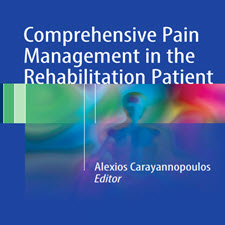Multiple Choice Questions in Pain Management
ABSTRACT
A multiple-choice-questions book is not only meant to test the knowledge but also serve as a concise guide for revision. It should also be able to help save time acquiring the vast amount of knowledge from books. The purpose of writing Multiple Choice Questions in Pain Management is to provide the relevant information in an interesting format. There are exit examinations all over the world after the pain fellowships for which there is no book available. This book also fills this gap for the trainees who are taking MCQ-based examination in the speciality. This volume is divided into ten chapters. The chapters provide a systemic approach to chronic pain starting from anatomy and physiology to the complexities of specialised pain. The book starts with a chapter on basic considerations which is one of the most complex topics to understand. This is followed by the process of evaluation and pharmacological management especially the mechanisms involved. The book then discusses in detail the two main divisions of pain, somatic and neuropathic pain. The book further discusses specialised areas of pain like visceral pain, cancer pain and head and neck pain. The chapter on miscellaneous questions delves into specialised groups like pregnant population, paediatric population and elderly population. Effort has been made to frame questions based on evidence available in the literature. The highlighting feature of the book is detailed answers explaining the complex information in a format which is easy to grasp. The book is not intended just to be a MCQ book but a concise pocket book explaining relevant concepts. It is meant for trainees but will serve an equal purpose for specialists who want to freshen their knowledge.
INTRODUCTION
Questions: 1. Coupling of action potential activity of C fibres: (a) Involves activation of one fibre by action potential activity in the another fibre. (b) Site of coupling is always near the receptor. (c) May contribute to flare response. (d) Is never seen in the peripheral nerves. (e) Frequently involves conventional C fibre mechano-heat-sensitive nociceptors. 2. Cold pain sensation: (a) Is mediated by both A and C fibres. (b) The sensation is subserved by deep structures. (c) Transient receptor potential ankyrin 1 (TRPA1) is the main receptor involved (d) The threshold at which receptors are activated is 14 celsius. (e) The response increases with gentle cooling.
چکیده
کتاب چند گزینه ای سوالات نه تنها برای آزمایش دانش است، بلکه به عنوان راهنمای مختصر برای تجدید نظر نیز خدمت می کند. همچنین باید قادر به صرفه جویی در وقت برای کسب دانش گسترده از کتاب باشد. هدف از نوشتن سوالات انتخاب چندگانه در مدیریت درد، ارائه اطلاعات مربوطه در فرمت جالب است. امتحانات خروج در سراسر جهان پس از کمک های درد که برای آن کتاب موجود نیست وجود دارد. این کتاب همچنین این شکاف را برای کارآموزانی که در معاینه MCQ مبتنی بر تخصص هستند، پر می کند. این حجم به ده فصل تقسیم شده است. فصل ها یک رویکرد سیستمیک به درد مزمن را از طریق آناتومی و فیزیولوژی به پیچیدگی های درد تخصصی ارائه می دهند. این کتاب با مقدمه ای بر ملاحظات اساسی شروع می شود که یکی از پیچیده ترین موضوعاتی است که باید درک شود. این به دنبال فرآیند ارزیابی و مدیریت دارویی به ویژه مکانیزم های درگیر است. این کتاب سپس به دو بخش عمده درد، درد جسمی و نوروپاتیک بحث می کند. این کتاب در مورد مناطق تخصصی درد مانند درد احشایی، درد سرطان و درد سر و گردن بحث می کند. فصل در مورد سوالات متداول به گروه های تخصصی مانند جمعیت باردار، جمعیت اطفال و سالمندان می پردازد. تلاش برای ایجاد سوالات مبتنی بر شواهد موجود در ادبیات انجام شده است. ویژگی برجسته کتاب، پاسخ دقیق به توضیح اطلاعات پیچیده در فرمت است که آسان است درک کنید. این کتاب تنها به عنوان یک کتاب MCQ در نظر گرفته نشده بلکه یک کتاب جیب کوچک است که مفاهیم مرتبط را توضیح می دهد. این به معنای آموزش کارآموزان است، اما برای متخصصانی که مایلند دانش خود را ارتقا دهند، اهداف مساوی دارند.
مقدمه
سوالات: 1. اتصال فعالیت پتانسیل عمل C از الیاف: (الف) شامل فعال سازی یک فیبر با فعالیت پتانسیل عمل در فیبر دیگر. (ب) محل اتصال همیشه در نزدیکی گیرنده است. (ج) ممکن است به پاسخ عفونت کمک کند. (د) هرگز در اعصاب محیطی دیده نمی شود. (الف) اغلب نئوسیتپتورهای مادون قرمز مکانیک حرارت متداول C را شامل می شود. 2. احساس درد سرد: (الف) به واسطه هر دو الیاف A و C بکار می رود. (ب) احساس توسط سازه های عمیق (c) پتانسیل گیرنده بالقوه ankyrin 1 (TRPA1) گیرنده اصلی است (d) آستانه که گیرنده فعال است 14 سلسس. (e) پاسخ با خنک کننده ملایم افزایش می یابد.
Year: 2016
Publisher: SPRINGER
By : Rajesh Gupta
File Information: English Language/ 219 Page / size: 586 KB
سال : 1395
ناشر : SPRINGER
کاری از : راجش گپتا
اطلاعات فایل : زبان انگلیسی / 219 صفحه / حجم : KB 586


![Multiple.Choice.Questions.in.Pain.Management.[taliem.ir]](https://taliem.ir/wp-content/uploads/Multiple.Choice.Questions.in_.Pain_.Management.taliem.ir_.jpg)


![Multidisciplinary.Management.of.Liver.[taliem.ir]](https://taliem.ir/wp-content/uploads/Multidisciplinary.Management.of_.Liver_.taliem.ir_-150x150.jpg)
![Molecular.Targeted.Therapy.of.Lung.Cancer.[taliem.ir]](https://taliem.ir/wp-content/uploads/Molecular.Targeted.Therapy.of_.Lung_.Cancer.taliem.ir_-150x150.jpg)
دیدگاه خود را ثبت کنید
تمایل دارید در گفتگو شرکت کنید؟نظری بدهید!